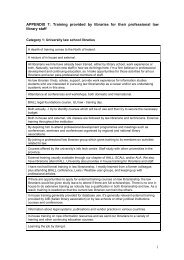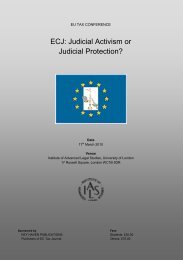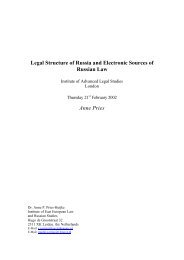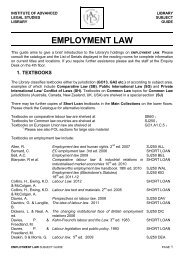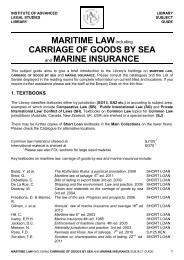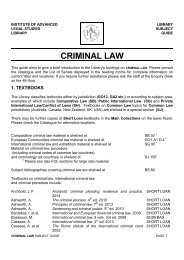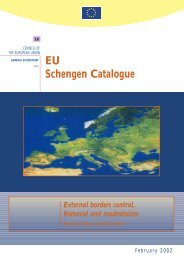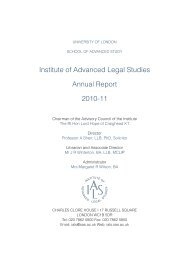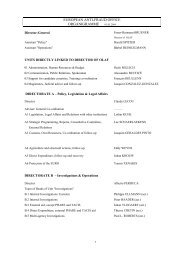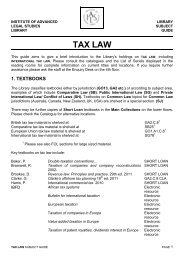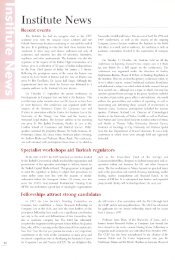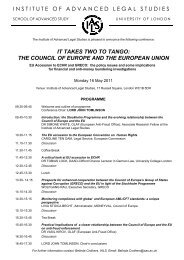a thesis - Institute of Advanced Legal Studies
a thesis - Institute of Advanced Legal Studies
a thesis - Institute of Advanced Legal Studies
Create successful ePaper yourself
Turn your PDF publications into a flip-book with our unique Google optimized e-Paper software.
6 TRUSTS IN GENERAL.<br />
time be said to be one <strong>of</strong> their distinguishing marks. Further, it<br />
is scarcely accurate to distribute all trusts into the classes <strong>of</strong> those<br />
" expressly undertaken" and constructive trusts. The trustee<br />
(save when the author <strong>of</strong> the trust constitutes himself a trustee),<br />
even in the case <strong>of</strong> express trusts, generally does not express his<br />
assent to undertake it. It would be more correct to distinguish<br />
between trusts which are imposed expressly and constructive trusts.<br />
It should perhaps be added that in the 5th and 6th editions <strong>of</strong> his<br />
book, Mr. Underbill has modified his definition so as in part to<br />
meet the criticisms here advanced.<br />
Lord Justice Lindley (1897, In re Williams, (1897) 2 Ch. 19).—<br />
" A trust is really nothing except a confidence reposed by one<br />
person in another and enforceable in a court <strong>of</strong> equity."<br />
This is substantially the same as Lord Hardwieke's, given<br />
above, and is subject to the same objections as his.<br />
Now, in order to construct a definition which shall not be open<br />
to the criticisms urged against those set out above, it is necessary<br />
to inquire what are the distinguishing marks <strong>of</strong> a trust, for the<br />
definition should include all those and none others.<br />
" A definition, in order to be satisfactory, ought to give with<br />
precision the marks whereby the thing to be defined is distinguished<br />
from all other things." (Lawrence, International Law, 1.)<br />
For this purpose it is advisable to see, in the first place, what<br />
relation the law <strong>of</strong> trusts bears to other branches <strong>of</strong> our law.<br />
There can be no doubt that a trust possesses some characteristics<br />
which are closely analogous to those <strong>of</strong> a contract. (See Pollock,<br />
Contracts, 6th ed. 195; Anson, Contracts, 8th ed. 8; Enc. Brit.<br />
Art. "Trust"; Enc. Eng. Law, Intro. vol. i. 11; Underbill,<br />
Trusts and Trustees, 6th ed. 3.)<br />
This analogy is specially marked in the case <strong>of</strong> that class <strong>of</strong> contracts<br />
known as bailments. These, indeed, are not infrequently<br />
spoken <strong>of</strong> as trusts (see, e.g., Blackstone, Comm. iii. 432), and it<br />
seems impossible to distinguish a depositum bailment from what is<br />
sometimes called a simple or bare trust. It is common usage to<br />
speak <strong>of</strong> a depositee as a trustee (see, e.g., Lord Hollis's Case (1686),<br />
2 Vent. 345; the judgment <strong>of</strong> Holt, C. J., in Coggs v. Bernard<br />
(1702), 1 Sm. L. C. 10th ed. 167; and both argument and judgment<br />
in In re Tidd, (1893) 3 Ch. 154), and authority may even be<br />
found for extending this to all bailments. Thus it is stated by



